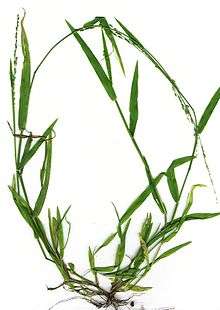Nardus
Nardus is a genus of plants belonging to the grass family, containing the single species Nardus stricta, known as matgrass.[3] It is placed in its own tribe Nardeae within the subfamily Pooideae. The name derives from nardos (νάρδος), the ancient Greek name for this plant. It is not to be confused with spikenard, Nardostachys jatamansi.
| Matgrass | |
|---|---|
| Scientific classification | |
| Kingdom: | Plantae |
| Clade: | Tracheophytes |
| Clade: | Angiosperms |
| Clade: | Monocots |
| Clade: | Commelinids |
| Order: | Poales |
| Family: | Poaceae |
| Clade: | BOP clade |
| Subfamily: | Pooideae |
| Supertribe: | Nardodae |
| Tribe: | Nardeae W. D. J. Koch |
| Genus: | Nardus L. |
| Species: | N. stricta |
| Binomial name | |
| Nardus stricta | |
| Synonyms[1][2] | |
| |
Distribution and ecology
Nardus stricta is native to Eurasia (from Iceland and the Azores to Mongolia), North Africa (Algeria, Morocco), and northeastern North America (Greenland, eastern Canada, and the northeastern United States).[1][4]
Nardus stricta occurs on heath, moorland, hills, and mountains on nutrient poor acidic sandy to peaty soils and is strongly calcifuge, avoiding calcareous soils. It can occur from low elevations to over 1,000 metres (3,300 ft), becoming a community-dominant in late snow patches on mountains. Nardus stricta may also become a dominant species in habitats grazed by cattle or sheep because it is tough and unpalatable.[5][6]
It flowers from June until August. Apomixis is found to be common in this plant, with extensive colonies often proving to be a single clone.
Description
Culms are erect and 25–60 centimetres (10–20 in) long, with grey-green leaf-blades filiform and involute, ranging from 4–30 cm (2–10 in) long by 0.5–1 millimetre (0.02–0.04 in) wide, i.e. bristle like. The ligules of basal leaves are 0.4–0.8 mm (0.02–0.03 in) long and blunt, while those of culm leaves are longer, up to 2 mm (0.08 in), and more pointed.[7]
The roots and shoots are very closely packed together at the base of the plant producing a white, tough, highly reflective feature. The spikelets are very slender and loosely overlapping in two rows each side of the spikelet axis. Each lemma is tipped with a short awn.[8]
References
- Kew World Checklist of Selected Plant Families
- Tropicos, Nardus L.
- "BSBI List 2007". Botanical Society of Britain and Ireland. Archived from the original (XLS) on 2015-01-25. Retrieved 2014-10-17.
- "Nardus". The Plant List. Retrieved 30 January 2016.
- Brynmor Thomas & C. B. Fairbairn (1956). "The white bent (Nardus stricta): its composition, digestibility and probable nutritive value". Grass and Forage Science. 11 (4): 230–234. doi:10.1111/j.1365-2494.1956.tb00079.x.CS1 maint: uses authors parameter (link)
- D. Welch (1986). "Studies in the grazing of heather moorland in north-east Scotland. V. Trends in Nardus stricta and other unpalatable graminoids". Journal of Applied Ecology. 23 (3): 1047–1058. doi:10.2307/2403954. JSTOR 2403954.
- Tom Cope & Alan Gray (2009). Grasses of the British Isles. BSBI Handbook. 13. London, UK: Botanical Society of the British Isles. p. 53. ISBN 978-0-901158-42-0.CS1 maint: uses authors parameter (link)
- C. E. Hubbard (1984). Grasses: a Guide to their Structure, Identification, Uses and Distribution in the British Isles (3rd ed.). Penguin Books. p. 343. ISBN 978-0-14-013227-4.
External links


- USDA Plants Database
- Germplasm Resources Information Network (GRIN)
- Global Biodiversity Information Facility (GBIF)
- Original description by Carl Linnaeus in Species Plantarum (1753)
